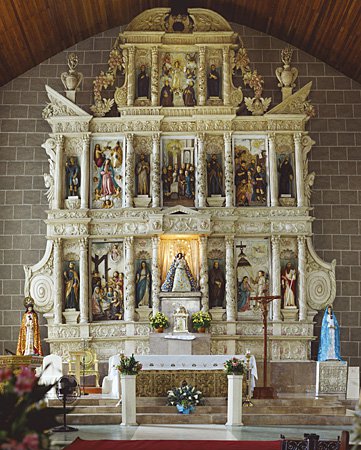Cultural Center of the Philippines
ENCYCLOPEDIA OF
PHILIPPINE ART
[Silang Retablos]

Main retablo and altar of Silang Church (Photo from Fr. Marty Dimaranan and Phillip Medina, Silang Parish Council for Culture and Heritage)
Completed ca 1671 / Wood, gesso, paint / Artist: Anonymous / Silang, Cavite
The Nuestra Señora de Candelaria Church in Silang, Cavite, houses three retablos or reredos, wall-like structures with sections for religious images—namely, the retablo mayor and two collaterals found on the epistle and gospel sides of the church. The retablo mayor is the church’s main altarpiece and is dated to the second half of the 17th century, some three decades after the stone church was built under the supervision of Fr Juan de Salazar, SJ. It is probable that the retablos were built in stages, the images of Christian martyrs and saints installed only after the dates of their beatification or canonization.
The retablo mayor subscribes closely to the template for many retablos throughout the islands. Largest of the retablos in the Silang Church, it is rendered in wood, gesso, and paint, and is thin with a flat rather than undulating surface. It has three tiers with symmetrically disposed niches and relleves (bas-reliefs), decorated with motifs inspired by different cultures. Conforming to practices then, the retablo was made from modular pieces of wood, no member more than two and a half meters long, with parts contracted to different artisans and later pieced together in the church where they were painted and gilded. The retablo mayor underwent refurbishing throughout the years. Its last maintenance work, done in the 20th century by the Talleres de Maximo Vicente, involved repainting with soft pastel colors.
Retablos had catechetical intent, and in Silang, the main altar functions as a “visual hagiography” (Javellana 1991, 116, 122) of the Virgin Mary. Both the freestanding sculptures and bas-reliefs in the retablo make reference to important “events” in her life—from her Immaculate Conception (relleve on the altar table) to her Coronation as the Queen of Heaven (leftmost relleve on the second tier). The images in the central sections of both the first and second tiers also invoke her title as the Virgin of Candelaria, a reference to Christ’s presentation in the temple, represented in iconography by the Virgin carrying the child Jesus in one arm, while her other hand holds a candle. Despite the importance given to the Virgin in the retablo mayor, it is the Santo Niño de Ternate, flanked by Jesuit saints and angels with musical instruments, who occupies the central niche in the topmost tier.
While the main retablo is devoted to the Virgin’s role in the Christ story, the two transept retablos emphasize other Christian personages. The epistle transept (on the right side facing the altar) depicts Jesuit male saints and blessed; while the gospel transept (on the left side facing the altar) features women saints, with the exception of one male saint, probably Paul. The topmost niche of the epistle transept represents the Japanese martyrs, Paul Miki and his companions, whose cult came to Manila during the 16th century after news of their death by crucifixion. Saint Teresa of Avila’s transverberation or spiritual marriage is depicted in the gospel transept, in what appears to be a continuous narrative—the Christ Child is seen shooting the arrow of Divine Love guided by Joseph and Mary, while Teresa appears to be reeling from the arrow that pierced her heart. Golden rays, swirling clouds, and hovering cherubs surround her, symbolizing her heavenly experience.
Taken together, the sculptures in these retablos highlight Marian devotion, yet acknowledge the centrality of Christ. The images also reflect the Jesuit contribution to the panoply of the holy, represented by its “soldiers”—saints and martyrs—fulfilling their missions in different parts of the world. The depiction of women saints, on the other hand, reiterates the call to martyrdom and sainthood, exemplified by a devotion to God in both body and spirit, evidenced by chaste lives, service, and propagation of the faith.
The style of the retablos is an interesting blend of elements from Spanish, Mexican, Asian, and native artistic traditions. Plateresque elements, for example, may be found in the fine carving, resembling the work of plateros (silversmiths), from which the style takes its name. The use of plant motifs, medallions, twisted or Solomonic columns, and polychrome are also associated with this style. At the same time, baroque features are evident in the use of split pediments and the overall density of the ornamentation, though still quite controlled. A rococo element, on the other hand, is represented by the cream-colored paint used as the base color of the entire retablo. The rendering of hills and clouds seems to have been Chinese-inspired, while the dwarf-like forms of some of the figures have a naive and folksy quality. This curious mix of elements from various cultures gives this retablo its peculiar charm and intimates, as well, the various sources from which Philippine art may draw inspiration.
Written by Marilyn R. Canta
Related Content
Sources
Jacinto-Lopez, Letty. 2001. “Faith Etched in Wood.” Philstar.com, 15 Dec. http://www.philstar.com/modern-living/143724/faith-etched-wood.
Javellana, Rene B. 1991. Wood and Stone for God’s Greater Glory: Jesuit Art and Architecture in the Philippines. Quezon City: Ateneo de Manila University Press.
Medina, Phillip N. A. L. 2013. “Erihiya, Retablo at mga Banal na Hiyas: Mga Piling Yamang Bayan ng Silang, Cavite na May Kaugnayan sa Pananampalataya sa Panahon ng mga Heswita noong 1599-1768.” Saliksik E-journal, 2, no. 1 (Sep): 60-99.
Unabia, Teresita P., Rosanni R. Sarile, and Bernardo N. Sepeda. 2012. “The Virgins of Cavite: Religiosity, Arts and History.” Slideshare.net. Posted 21 Jun. Accessed 23 Jul 2014.